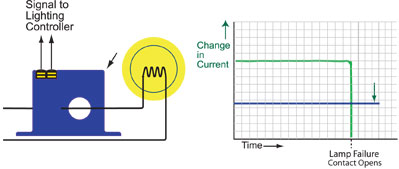Since the early 1980’s, one piece, self-powered current operated switches have required the trip point to be adjusted while the monitored load is energized. The original design used a multiple-turn potentiometer making it uneconomical to display how much current would cause the sensor to trip.
The new ASL current switch provides a patent pending linear setpoint adjustment using a single-turn potentiometer. The actual current magnitude which will trip the sensor output is indicated on the sensor. The installer turns the adjustment knob so the arrow points at the amperage value they select.
Each sensor is provided with a calibrated dial, with the amperes shown where the solid-state sensor contact will trip or change state (normally open contact closes on current increase, normally closed contact opens on current increase). There are four ranges available for either solid or split core case types:
ASL Current Operated Switch with Linear Adjustment
The new ASL AC Series current operated switches are powered from the monitored circuit so no power supply is needed, making installation easy. The trip point is adjusted with a single 3/4 turn selector, with the current shown on the label. Point the selector to the amp level where you want the solid-state contact to change state (open or close depending on the model), and connect the sensor terminals to switch a control voltage, AC or DC, to a PLC, panel meter or other controller. The setpoint adjustment can be made before the sensor is installed or after and is designed not to drift during operation. Once it is set, you can be confident there will be no call backs.
Related Products
AC Current Switch Applications
- Fans: Verification of operation and drive belt integrity
- Pumps: Detect loss of head pressure, failing bearings, open discharge and cavitation
- Heating element operation
- Air compressors
- Shredders and grinders
- Water treatment facilities
- Sewage lift stations
- Critical lighting (navigation and signals)

Critical lighting loads like waterway navigation lights are relied on by ship captains and tug boat pilots to keep their vessels from harm. If a lamp fails, a reliable way to detect this drop in current is to use a current operated switch. The switch contact can be used to set off an alarm or change to a back-up lamp. The alternative method is to use a photocell and have a contact change state if the cell suddenly was engulfed in darkness. The complexity of this setup has several drawbacks including keeping the photocell clean and aligned with the navigation lamp, along with the cell requiring power to operate. Unlike photocell technology, ASL current switches will work regardless of the voltage to the lamp and can be installed far from the lamp fixture near the circuit breaker feeding the lamp, or in a separate enclosure.

